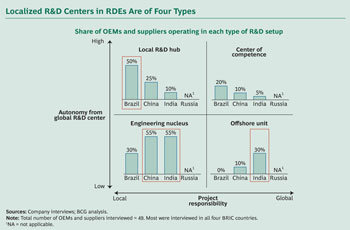
Although some research and development work has shifted from mature markets to the developing countries of Brazil, Russia, India and China, only a small percentage of auto makers and suppliers are using the up-and-coming BRIC nations as primary product-development sources on global-vehicle programs, a new study reveals.
The Boston Consulting Group, which worked with 20 OEs, 29 suppliers and a handful of universities in compiling the report, “Winning the BRIC Auto Markets,” says only 20% are using Brazil as a “Center of Competence” in the development of global products.
That percentage falls to 10% for China and 5% for India, the consultancy says.
No engineering work of any kind is under way by multinationals in Russia, despite the fact the country graduates “an impressive 400,000 engineers a year,” the study says.
The reason? Russian consumers prefer to buy vehicles that are identical to those sold in the West, so there is no need for auto makers to adapt existing vehicles to unique market preferences the way they do in China or Brazil.
In addition, local OEs “have not provided a strong foundation for developing automotive experience,” so there isn’t a skilled workforce available to contribute to global engineering programs. Finally, wages have been rising at 20% per annum and are now at about 50% of Western rates, limiting much of the labor-cost advantage of R&D in Russia.
Including the centers of competence, BCG designates four classes of R&D investment in the BRIC countries.
![<link rel="stylesheet" href="http://subscribers.wardsauto.com/galleries/files/lightbox.css" type="text/css" media="screen" />
<script src="http://subscribers.wardsauto.com/galleries/files/prototype.js" type="text/javascript"></script>
<script src="http://subscribers.wardsauto.com/galleries/files/scriptaculous.js?load=effects" type="text/javascript"></script>
<script src="http://subscribers.wardsauto.com/galleries/files/lightbox.js" type="text/javascript"></script>
<p><a href="http://subscribers.wardsauto.com/galleries/2010/BRIC_Chart2_gallery.jpg" rel="lightbox[plants]" title=" ">Enlarge Graph</a></p>](http://subscribers.wardsauto.com/images/2010/01/BRIC_Chart2.jpg)
Some OEs and suppliers use the developing markets as “Offshore Units” that provide an engineering base for global programs on specific technologies. India is a prime example, where 30% of the multinationals source development of software programming and other electronics.
China and India lead among the four countries as bases for “Engineering Nucleus” centers, which BCG says are charged with adapting global products to local conditions. Of the OEs and suppliers studied, 55% have such operations in those two countries, compared with 30% in Brazil.
The final category is “Local R&D Hub,” chartered with developing products specific to the domestic market. Brazil is the best example, where there is considerable engineering activity focused on flex-fuel engines and components.
Somewhat surprising, the study’s authors say, is that India has not localized more engineering.
“With Indian universities graduating some 500,000 engineers a year, and wages well below those in the triad markets (U.S, Western Europe, Japan), one might expect that foreign auto makers would choose to conduct large portions of their R&D in India,” BCG says.
But even though “Indian consumers have the most distinctive automotive requirements,” including a growing penchant for sub-$5,000 vehicles, foreign OEs have not invested much in modifying products to meet local demands.
“Moreover, they generally lead whatever adaptations they make from their R&D headquarters in the triad markets,” the study notes.
China, which graduates an astounding 1.8 million engineers annually, is a different story, where 25% of engineering centers focus on tweaking products to fit domestic requirements.
But competition in the fast-growing market for well-trained engineers is fierce. BCG says China is an “attractive” locale for engineering investment “as long as employees can be retained.”
Of the four countries, India and Brazil are most likely to emerge near term as dominant global engineering centers, India for embedded information technology systems and Brazil for alternative-fuel engines and related components.
Four companies – OEs General Motors Co. and Volkswagen AG and suppliers Robert Bosch GmbH and Delphi Automotive LLP – stand out as the best positioned in the BRIC countries. They are the only companies to invest in all four business facets – manufacturing, sourcing, engineering and sales – in all four markets, BCG says.




